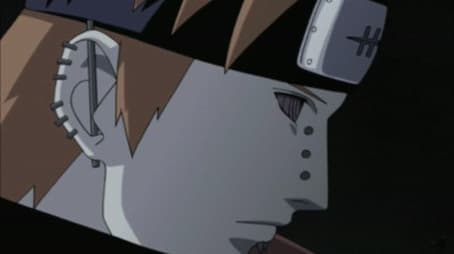
Ask Your Own Question
What is the plot?
The episode begins with a somber atmosphere as Naruto Uzumaki and his friends are still reeling from the recent events surrounding the Akatsuki and the loss of their mentor, Jiraiya. The scene opens in the Hidden Leaf Village, where Naruto is training hard, pushing himself to become stronger. He is determined to honor Jiraiya's memory and protect his friends. The emotional weight of Jiraiya's death hangs heavily over him, fueling his resolve.
Meanwhile, the focus shifts to Tsunade, the Fifth Hokage, who is in her office. She is deeply troubled by the information she has received regarding the Akatsuki's plans. Tsunade is seen contemplating the implications of Jiraiya's last mission and the potential threat posed by Pain, the leader of the Akatsuki. Her internal struggle is evident as she grapples with the burden of leadership and the safety of the village.
As the episode progresses, we see Naruto's friends, Sakura Haruno and Sai, join him in training. They are all motivated by the desire to become stronger and to avenge Jiraiya's death. During their training session, Naruto expresses his frustration and determination to become more powerful, showcasing his emotional state and the weight of his loss. Sakura and Sai support him, emphasizing their commitment to stand by his side.
The narrative then shifts to a flashback of Jiraiya, where he is seen writing his final book, "The Tale of the Gutsy Ninja." This moment is poignant, as it highlights Jiraiya's character and his hopes for Naruto. The flashback serves to deepen the emotional connection between Naruto and Jiraiya, illustrating the mentor-student bond they shared. Jiraiya's words resonate with Naruto, reinforcing his resolve to protect his friends and the village.
Back in the present, the scene transitions to a meeting in the Hokage's office, where Tsunade discusses the Akatsuki's movements with her advisors. They are concerned about the potential for an attack on the village. Tsunade's leadership is tested as she makes the difficult decision to prepare the village for a possible confrontation. The tension in the room is palpable as they strategize on how to counter the Akatsuki's threat.
As the episode continues, Naruto, Sakura, and Sai receive a mission from Tsunade. They are tasked with gathering intelligence on the Akatsuki and locating their hideout. This mission is crucial, as it could provide them with the information needed to thwart the Akatsuki's plans. The trio sets out, their determination evident as they embark on this dangerous task.
During their mission, they encounter various obstacles and challenges. The team faces off against several Akatsuki members, showcasing their growth and teamwork. Each character's abilities are highlighted, with Naruto's determination, Sakura's strength, and Sai's strategic thinking coming into play. The battles are intense, filled with emotional stakes as they fight not only for their mission but also in memory of Jiraiya.
As they delve deeper into enemy territory, they uncover critical information about Pain's true identity and his connection to the Akatsuki's plans. This revelation adds a layer of urgency to their mission, as they realize the extent of the threat they are facing. The emotional weight of their discoveries weighs heavily on Naruto, who feels the pressure of living up to Jiraiya's legacy.
The episode culminates in a tense confrontation with one of the Akatsuki members. The fight is fierce, with Naruto and his friends pushing themselves to their limits. The choreography of the battle is dynamic, showcasing their skills and the stakes involved. As the fight reaches its climax, Naruto's resolve shines through, embodying the spirit of Jiraiya as he fights for his friends and the village.
In the final moments of the episode, the team successfully retrieves the intelligence they need, but not without significant emotional tolls. They reflect on their journey and the sacrifices made, solidifying their commitment to protect the village and honor Jiraiya's memory. The episode ends on a note of determination, setting the stage for the challenges that lie ahead as they prepare to face the Akatsuki.
What is the ending?
In the ending of Naruto Shippūden, Season 6, Episode 125 titled "Disappearance," the episode concludes with the aftermath of the battle against the Akatsuki. Sasori's defeat leads to the revelation of his true feelings about his past and his connection to his parents. The episode ends with a somber tone as the characters reflect on loss and the weight of their choices.
As the episode unfolds, we begin with a tense atmosphere following the battle against Sasori. The scene opens with Sakura Haruno and Chiyo standing over the lifeless body of Sasori, who has just been defeated. The air is thick with a mix of triumph and sorrow. Sakura, having fought valiantly alongside Chiyo, feels a deep sense of loss for the life that Sasori led, despite his villainous actions. Chiyo, an elder kunoichi, reflects on her own past and the choices that led to this moment, revealing her emotional turmoil.
The camera shifts to the aftermath of the battle, where the sun begins to set, casting a warm glow over the battlefield. Sakura kneels beside Chiyo, who is visibly weakened from the fight. Chiyo expresses her regret over the path Sasori chose, lamenting that he could have been a different person had he not lost his way. This moment highlights the theme of lost potential and the impact of one's choices on their destiny.
As they prepare to leave, Chiyo reveals her plan to use a forbidden technique to revive the fallen. She understands the weight of her decision and the sacrifice it entails. The emotional stakes rise as Sakura pleads with her not to go through with it, fearing for Chiyo's life. However, Chiyo is resolute, believing that it is her duty to atone for her past mistakes. This moment encapsulates the theme of redemption and the lengths one will go to for those they care about.
In a poignant farewell, Chiyo uses her life force to bring back the fallen, showcasing her selflessness. As she performs the technique, the scene is filled with a bright light, symbolizing hope and renewal. The camera captures Sakura's tearful expression, a mix of gratitude and sorrow for the sacrifice being made. Chiyo's final words resonate with the audience, emphasizing the importance of cherishing life and the bonds formed through shared experiences.
As the light fades, we see the revived individuals, including the fallen, standing in a serene landscape. The emotional weight of the moment is palpable, as characters reflect on their journeys and the choices that led them to this point. The episode concludes with a sense of closure, yet leaves the audience pondering the complexities of life, loss, and the paths we choose.
In summary, the episode ends with Chiyo sacrificing herself to revive the fallen, leaving Sakura and the others to reflect on the themes of redemption, sacrifice, and the impact of choices on one's life. Each character is left with a deeper understanding of their own motivations and the importance of their connections to one another.
Is there a post-credit scene?
In the episode "Disappearance" from Naruto Shippūden, season 6, there is no post-credit scene. The episode concludes without any additional content after the credits roll. The focus remains on the main storyline and character developments throughout the episode, particularly revolving around the emotional turmoil and the impact of the events on the characters involved.
What happens to Sasori's body in this episode?
In episode 125, 'Disappearance', it is revealed that Sasori's body is left behind after his battle with Sakura and Chiyo. His body is ultimately taken by the Akatsuki, but the emotional weight of his defeat and the loss of his humanity is explored through his interactions with Chiyo.
How does Chiyo feel about her past actions in this episode?
Chiyo reflects on her past as a puppet master and the choices she made, particularly regarding her role in the death of the Third Kazekage. This introspection reveals her deep regret and the burden of her actions, which she carries as she faces Sasori.
What is the significance of the red sand in this episode?
The red sand is a symbol of Sasori's legacy and his connection to the Akatsuki. In this episode, it serves as a reminder of his past and the impact he had on the world, as well as the emotional ties he had with his former village and family.
How does Sakura's character develop during her fight with Sasori?
During her confrontation with Sasori, Sakura demonstrates significant growth in her abilities and confidence. She showcases her medical ninjutsu and combat skills, proving her worth as a ninja and her determination to protect her friends, particularly in her partnership with Chiyo.
What role does Chiyo play in the battle against Sasori?
Chiyo plays a crucial role in the battle against Sasori by using her extensive knowledge of puppetry and her own puppets to counter his techniques. Her experience and strategic thinking are vital in turning the tide of the battle, showcasing her as a formidable opponent despite her age.
Is this family friendly?
"Naruto Shippūden" is generally considered suitable for older children and teens, but it does contain some scenes that may be objectionable or upsetting for younger viewers or sensitive individuals. In episode 125, titled "Disappearance," the following aspects may be concerning:
-
Violence: There are intense battle scenes that include physical confrontations, injuries, and the use of jutsu (ninja techniques) that can be graphic in nature.
-
Death and Loss: Themes of loss and the emotional impact of characters disappearing or being lost are central to the episode, which may evoke feelings of sadness or distress.
-
Emotional Turmoil: Characters experience significant emotional struggles, including feelings of betrayal, despair, and hopelessness, which may be heavy for younger audiences.
-
Dark Themes: The episode touches on themes of vengeance and the consequences of one's actions, which can be complex and potentially unsettling for younger viewers.
These elements contribute to the overall tone of the episode, which may not be suitable for all children, particularly those who are sensitive to violence or emotional distress.











